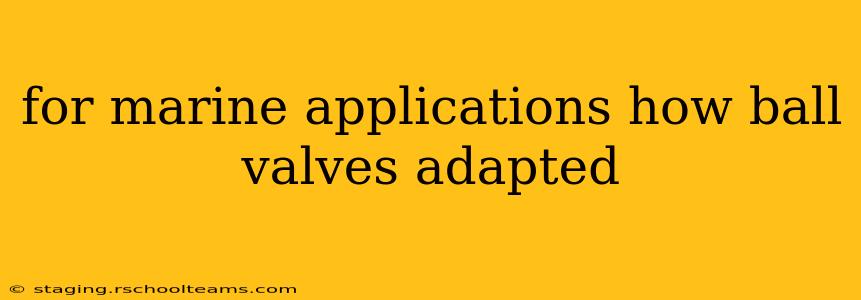Marine environments present unique challenges for valve systems. The constant exposure to saltwater, extreme temperature fluctuations, and demanding operational conditions necessitates specialized designs. This article explores how standard ball valves are adapted to thrive in the harsh marine setting, ensuring reliable performance in demanding applications.
What Makes Marine Environments So Demanding for Valves?
Before delving into adaptations, let's understand the specific challenges:
- Corrosion: Saltwater is highly corrosive, rapidly degrading many materials. This necessitates the use of corrosion-resistant alloys like stainless steel (various grades, often 316 or higher), duplex stainless steel, or even exotic materials like titanium or nickel alloys in critical applications.
- Erosion: The constant movement of water, especially in high-velocity applications, can cause erosion of valve components. Therefore, marine ball valves often incorporate features designed to minimize erosion, such as hardened seats and balls.
- Fouling: Marine growth (barnacles, algae, etc.) can accumulate on valves, hindering operation. Smooth surfaces and designs that minimize crevices are crucial to mitigate fouling.
- Vibration and Shock: The movement of a vessel introduces vibration and shock loads that can impact valve reliability. Robust construction and secure mounting are paramount.
- Temperature Variations: Marine environments experience wide temperature swings, affecting valve materials and sealing performance. The selection of materials with appropriate temperature resistance is vital.
- Pressure Fluctuations: Pressure changes are common in marine systems, demanding valves that can withstand these variations without leakage.
How are Ball Valves Adapted for Marine Use?
Standard ball valves undergo significant modifications to meet the demands of marine applications:
1. Material Selection: The Foundation of Durability
The choice of materials is critical. Instead of standard brass or carbon steel, marine ball valves utilize:
- Stainless Steel (316, 316L, Duplex): Offers excellent corrosion resistance and strength. 316L is preferred in applications susceptible to chloride stress corrosion cracking. Duplex stainless steels offer even greater corrosion resistance and strength.
- Nickel Alloys (Monel, Inconel): For exceptionally harsh environments requiring superior resistance to corrosion and high temperatures.
- Titanium: Excellent corrosion resistance and high strength-to-weight ratio, making it ideal for specific applications.
2. Enhanced Sealing Mechanisms: Preventing Leaks
Leakage is unacceptable in marine systems. Marine ball valves employ:
- High-quality sealing materials: Elastomers like Viton or Kalrez offer superior resistance to chemicals and high temperatures, maintaining a tight seal even under pressure.
- Reinforced seals: Some designs incorporate reinforced seals to withstand pressure and prevent extrusion.
- Metal-to-metal sealing: In critical applications, metal-to-metal sealing eliminates the risk of elastomer degradation.
3. Robust Construction and Design: Withstanding the Elements
- Thicker walls: Provide added strength to withstand pressure and vibration.
- Reinforced body: The valve body is often reinforced to minimize deformation under stress.
- Improved surface finish: A smooth, polished surface minimizes fouling and improves flow characteristics.
- Heavy-duty actuators: Manual or automated actuators are selected for durability and reliability in the marine environment.
4. Testing and Certification: Ensuring Compliance
Marine valves are rigorously tested and certified to meet stringent industry standards such as:
- DNV GL: Det Norske Veritas Germanischer Lloyd.
- ABS: American Bureau of Shipping.
- LR: Lloyd's Register.
These certifications verify compliance with specific performance requirements for marine applications.
Frequently Asked Questions (FAQs)
What are the common applications of marine ball valves?
Marine ball valves are used in a wide array of applications, including:
- Ballast water systems: Controlling the intake and discharge of ballast water.
- Fire protection systems: Controlling the flow of water in fire suppression systems.
- Fuel and lubrication systems: Managing the flow of fuel and lubricating oils.
- Bilge systems: Controlling the drainage of bilge water.
- Hydraulic systems: Regulating the flow of hydraulic fluids.
How do I choose the right marine ball valve for my application?
Selecting the right valve depends on factors such as:
- Fluid type and characteristics: (e.g., corrosive, viscous, temperature)
- Pressure and temperature ratings: Must meet or exceed operational requirements.
- Size and flow capacity: Ensure sufficient flow for the application.
- Material compatibility: Choose materials that resist corrosion and erosion from the specific fluid.
- Actuation method: Manual, pneumatic, or electric.
How often should marine ball valves be inspected and maintained?
Regular inspection and maintenance are crucial. The frequency depends on the application and valve usage, but it's generally recommended to conduct inspections at least annually, or more frequently in high-usage applications. Maintenance might include lubrication, checking for leaks, and verifying proper operation.
This article provides a comprehensive overview of how ball valves are adapted for marine applications. Choosing the appropriate valve requires careful consideration of the specific environmental conditions and operational requirements. Consulting with valve specialists is essential to ensure the selection of a reliable and durable valve for your marine application.
